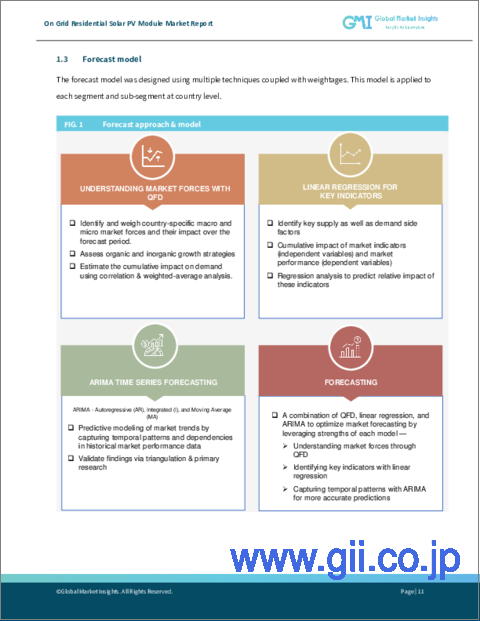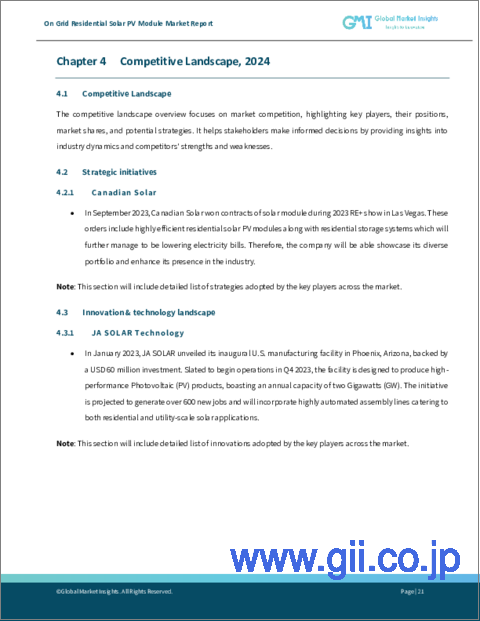|
|
市場調査レポート
商品コード
1615955
オングリッド住宅用太陽光発電モジュール市場の機会、成長促進要因、産業動向分析、2024~2032年の予測On Grid Residential Solar PV Module Market Opportunity, Growth Drivers, Industry Trend Analysis, and Forecast 2024 to 2032 |
||||||
カスタマイズ可能
|
|||||||
| オングリッド住宅用太陽光発電モジュール市場の機会、成長促進要因、産業動向分析、2024~2032年の予測 |
|
出版日: 2024年09月17日
発行: Global Market Insights Inc.
ページ情報: 英文 100 Pages
納期: 2~3営業日
|
- 全表示
- 概要
- 目次
オングリッド住宅用太陽光発電モジュールの世界市場規模は、2023年に581億米ドルとなり、2024年から2032年にかけてCAGR 4.7%で拡大すると予測されています。
一般にソーラーパネルと呼ばれる太陽光発電モジュールは、太陽光を電気に変換するフレームワーク内に組み合わされた複数の光電池で構成されています。これらのセルは通常、シリコンを中心とする半導体材料から作られており、太陽光を受けると光起電力効果によって電流が発生します。最近の太陽電池モジュール効率の動向は、20%を超える効率を達成する単結晶パネルのような最先端技術の開発につながった。このような高効率モジュールは、限られた屋根のスペースでより多くの電力を生産することを可能にし、ソーラーパネルの設置面積に制限がある物件では特に重宝されます。
太陽光を両側から取り込むように設計された二面式モジュールのような革新的技術も住宅部門で人気を集めており、市場の成長をさらに刺激しています。さらに、再生可能エネルギーの導入促進を目的とした政府の支援政策も、業界の勢いを高めると予想されます。設置タイプ別では、屋上部門が2032年までに780億米ドルを超えると予想されています。住宅所有者が余剰電力を送電網に売電できるようにする規制は、屋上ソーラーシステムの財政的実現可能性を大幅に改善し、利用者に追加収入やクレジットを提供します。多くの政府は、税額控除、リベート、補助金などの財政的インセンティブを導入し、屋上ソーラー・システム設置の初期費用を軽減しています。
これらのシステムは、家庭での発電を可能にすることで電気料金を大幅に削減し、系統電力への依存度を下げることができます。アジア太平洋地域のオングリッド住宅用太陽光発電モジュール市場は、技術革新、支援政策、電気料金の上昇を背景に、395億米ドルを超えると予想されています。いくつかの国では、住宅所有者が余剰太陽光エネルギーを送電網に売電できるネットメータリング制度を採用しており、オングリッドシステムの経済的魅力が高まっています。さらに、さまざまな政府が太陽光発電設備に必要な初期投資を相殺するための補助金や税制優遇措置を提供しており、オングリッド住宅システムの普及を促進しています。さらに、気候変動に関する公約に沿った野心的な再生可能エネルギー目標が、住宅用太陽光発電技術の採用を後押しするとみられます。
| 市場範囲 | |
|---|---|
| 開始年 | 2023 |
| 予測年 | 2024-2032 |
| 開始金額 | 581億米ドル |
| 予想金額 | 866億米ドル |
| CAGR | 4.7% |
目次
第1章 調査手法と調査範囲
第2章 エグゼクティブサマリー
第3章 業界洞察
- 業界エコシステム
- 規制状況
- 業界への影響要因
- 促進要因
- 業界の潜在的リスク&課題
- 成長ポテンシャル分析
- 価格動向分析
- ポーター分析
- PESTEL分析
第4章 競合情勢
- イントロダクション
- 戦略ダッシュボード
- イノベーションとテクノロジーの展望
第5章 市場規模・予測:取付別、2021年~2032年
- 主要動向
- 地上取付型
- 屋上取付型
第6章 市場規模・予測:地域別、2021年~2032年
- 主要動向
- 北米
- 米国
- カナダ
- 欧州
- ドイツ
- オランダ
- ポーランド
- フランス
- 英国
- スペイン
- アジア太平洋
- 日本
- 韓国
- 中国
- インド
- ベトナム
- 中東
- イスラエル
- サウジアラビア
- アラブ首長国連邦
- ヨルダン
- トルコ
- アフリカ
- 南アフリカ
- エジプト
- アルジェリア
- ナイジェリア
- モロッコ
- ラテンアメリカ
- チリ
- アルゼンチン
- ペルー
第7章 企業プロファイル
- Chint Group
- Canadian Solar
- First Solar
- Indosolar
- JA Solar Technology Co., Ltd
- Jinkosolar
- Lg Electronics
- Longi
- Motech Industries Inc.
- Risen Energy Co., Ltd
- Renesola
- Shunfeng International Clean Energy Co., Ltd
- Solar Frontier K.K.
- Sunpower Corporation
- The Solaria Corporation
- Trina Solar
- Vikram Solar Ltd
- Yingli Solar
The Global On Grid Residential Solar PV Module Market was valued at USD 58.1 billion in 2023 and is projected to expand at a CAGR of 4.7% from 2024 to 2032. Solar PV modules, commonly termed as solar panels, consist of multiple photovoltaic cells assembled within a framework that converts sunlight into electricity. These cells are typically made from semiconductor materials, primarily silicon, which generate an electric current when exposed to sunlight through the photovoltaic effect. Recent advancements in solar module efficiency have led to the development of cutting-edge technologies, such as monocrystalline panels, which achieve efficiencies exceeding 20%. These high-efficiency modules enable homeowners to produce more electricity within a limited roof space, making them particularly valuable for properties with restricted solar panel installation areas.
Innovations like bifacial modules designed to capture sunlight from both sides are also gaining popularity in the residential sector, further stimulating market growth. Additionally, supportive government policies aimed at promoting renewable energy adoption are expected to enhance the momentum of the industry. In terms of installation type, the rooftop segment is anticipated to surpass USD 78 billion by 2032. Regulations that allow homeowners to sell surplus electricity back to the grid significantly improve the financial feasibility of rooftop solar systems, providing additional income or credits to users. Many governments are implementing financial incentives, such as tax credits, rebates, and grants, to alleviate the initial costs of installing rooftop solar systems.
These systems can drastically reduce electricity expenses by enabling homeowners to generate energy, thus decreasing their dependence on grid electricity. The Asia-Pacific market for on-grid residential solar PV modules is expected to exceed USD 39.5 billion, driven by technological innovations, supportive policies, and rising electricity costs. Several nations have adopted net metering schemes that enable homeowners to sell excess solar energy back to the grid, increasing the financial attractiveness of on-grid systems. Additionally, various governments are providing subsidies and tax incentives to help offset the initial investment required for solar installations, promoting the uptake of on-grid residential systems.Furthermore, ambitious renewable energy targets, in line with climate commitments, will likely boost the adoption of solar PV technology in residential applications.
| Market Scope | |
|---|---|
| Start Year | 2023 |
| Forecast Year | 2024-2032 |
| Start Value | $58.1 Billion |
| Forecast Value | $86.6 Billion |
| CAGR | 4.7% |
Table of Contents
Chapter 1 Methodology & Scope
- 1.1 Research design
- 1.2 Base estimates & calculations
- 1.3 Forecast model
- 1.4 Primary research & validation
- 1.4.1 Primary sources
- 1.4.2 Data mining sources
- 1.5 Market definitions
Chapter 2 Executive Summary
- 2.1 Industry 360° synopsis, 2021 - 2032
Chapter 3 Industry Insights
- 3.1 Industry ecosystem
- 3.2 Regulatory landscape
- 3.3 Industry impact forces
- 3.3.1 Growth drivers
- 3.3.2 Industry pitfalls & challenges
- 3.4 Growth potential analysis
- 3.5 Price trend analysis
- 3.6 Porter's analysis
- 3.6.1 Bargaining power of suppliers
- 3.6.2 Bargaining power of buyers
- 3.6.3 Threat of new entrants
- 3.6.4 Threat of substitutes
- 3.7 PESTEL analysis
Chapter 4 Competitive landscape, 2023
- 4.1 Introduction
- 4.2 Strategic dashboard
- 4.3 Innovation & technology landscape
Chapter 5 Market Size and Forecast, By Mounting, 2021 - 2032 (USD Million & MW)
- 5.1 Key trends
- 5.2 Ground mounted
- 5.3 Rooftop
Chapter 6 Market Size and Forecast, By Region, 2021 - 2032 (USD Million & MW)
- 6.1 Key trends
- 6.2 North America
- 6.2.1 U.S.
- 6.2.2 Canada
- 6.3 Europe
- 6.3.1 Germany
- 6.3.2 Netherlands
- 6.3.3 Poland
- 6.3.4 France
- 6.3.5 UK
- 6.3.6 Spain
- 6.4 Asia Pacific
- 6.4.1 Japan
- 6.4.2 South Korea
- 6.4.3 China
- 6.4.4 India
- 6.4.5 Vietnam
- 6.5 Middle East
- 6.5.1 Israel
- 6.5.2 Saudi Arabia
- 6.5.3 UAE
- 6.5.4 Jordan
- 6.5.5 Turkey
- 6.6 Africa
- 6.6.1 South Africa
- 6.6.2 Egypt
- 6.6.3 Algeria
- 6.6.4 Nigeria
- 6.6.5 Morocco
- 6.7 Latin America
- 6.7.1 Chile
- 6.7.2 Argentina
- 6.7.3 Peru
Chapter 7 Company Profiles
- 7.1 Chint Group
- 7.2 Canadian Solar
- 7.3 First Solar
- 7.4 Indosolar
- 7.5 JA Solar Technology Co., Ltd
- 7.6 Jinkosolar
- 7.7 Lg Electronics
- 7.8 Longi
- 7.9 Motech Industries Inc.
- 7.10 Risen Energy Co., Ltd
- 7.11 Renesola
- 7.12 Shunfeng International Clean Energy Co., Ltd
- 7.13 Solar Frontier K.K.
- 7.14 Sunpower Corporation
- 7.15 The Solaria Corporation
- 7.16 Trina Solar
- 7.17 Vikram Solar Ltd
- 7.18 Yingli Solar






